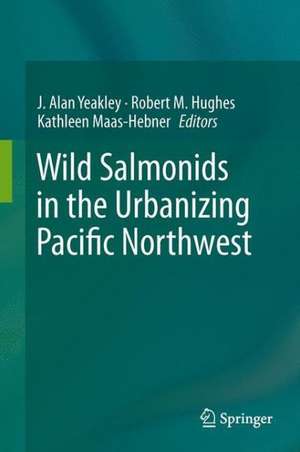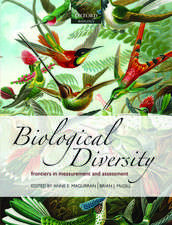Wild Salmonids in the Urbanizing Pacific Northwest
Editat de J. Alan Yeakley, Kathleen G. Maas-Hebner, Robert M. Hughesen Limba Engleză Hardback – 21 noi 2013
| Toate formatele și edițiile | Preț | Express |
|---|---|---|
| Paperback (1) | 943.73 lei 6-8 săpt. | |
| Springer – 23 aug 2016 | 943.73 lei 6-8 săpt. | |
| Hardback (1) | 949.73 lei 6-8 săpt. | |
| Springer – 21 noi 2013 | 949.73 lei 6-8 săpt. |
Preț: 949.73 lei
Preț vechi: 1158.20 lei
-18% Nou
Puncte Express: 1425
Preț estimativ în valută:
181.73€ • 198.02$ • 153.13£
181.73€ • 198.02$ • 153.13£
Carte tipărită la comandă
Livrare economică 23 aprilie-07 mai
Preluare comenzi: 021 569.72.76
Specificații
ISBN-13: 9781461488170
ISBN-10: 1461488176
Pagini: 270
Ilustrații: VIII, 271 p. 55 illus., 45 illus. in color.
Dimensiuni: 155 x 235 x 20 mm
Greutate: 0.57 kg
Ediția:2014
Editura: Springer
Colecția Springer
Locul publicării:New York, NY, United States
ISBN-10: 1461488176
Pagini: 270
Ilustrații: VIII, 271 p. 55 illus., 45 illus. in color.
Dimensiuni: 155 x 235 x 20 mm
Greutate: 0.57 kg
Ediția:2014
Editura: Springer
Colecția Springer
Locul publicării:New York, NY, United States
Public țintă
ResearchCuprins
Chapter 1. Introduction to Wild Salmonids in the Urbanizing Pacific Northwest (Yeakley).- Chapter 2. Global and Regional Context of Salmonids and Urban Areas (Yeakley, Hughes).- Chapter 3. Regulatory and Planning Approaches to Protecting Salmonids in Urbanizing Environments (Molina).- Chapter 4. Socio-Ecological Context of Salmonids in the City (Shandas).- Chapter 5. Urban Hydrology in the Pacific Northwest (Yeakley).- Chapter 6. Urbanization Impacts on Pacific Northwest Aquatic and Riparian Habitats (Maas-Hebner, Dunham).- Chapter 7. Fish Passage through Urban and Rural-Residential Areas (Hughes, Dunham).- Chapter 8. Water Quality in Pacific Northwest Urban and Urbanizing Aquatic Ecosystems (Yeakley).- Chapter 9. Toxic Contaminants in the Urban Aquatic Environment (Foster, Curtis, Gundersen).- Chapter 10. Wastewater Treatment and the Urban Aquatic Environment (Dunham).- Chapter 11. Aquatic Biota in Urban Areas (Hughes, Dunham).- Chapter 12. Wild Salmonids in the Urban Environment: Lethal and Sublethal Effects (Maas-Hebner, Hughes, Schreck).- Chapter 13. Rehabilitating Aquatic Ecosystems in Developed Areas (Maas-Hebner).- Chapter 14. Prioritizing, Monitoring, Assessing, and Communicating Rehabilitation Efforts in Urbanized Watersheds (Maas-Hebner).- Chapter 15. Market-Based Strategies to Offset New Development Impacts on Aquatic Ecosystems (Maas-Hebner and Dunham).- Chapter 16. Watershed and Landscape Actions for Mitigating Impacts on Urban Salmonids (Yeakley, Dunham).- Chapter 17. Major Research and Monitoring Needs for Urban Streams and Watersheds (Hughes, Yeakley).- Chapter 18. Summary of Salmonid Rehabilitation Lessons from the Pacific Northwest (Yeakley, Maas-Hebner, Hughes).
Notă biografică
J. Alan Yeakley earned his Ph.D. in environmental science from the University of Virginia in 1993. His areas of research interest include watershed hydrology, biogeochemistry, plant ecology and urban ecology. Alan held a post-doc jointly funded by the University of Georgia and the US Forest Service prior to taking a faculty position at Portland State University (PSU) in 1994. At PSU, he helped found the Department of Environmental Science & Management, and was recently appointed Director of the School of Environment. Alan has been a member of the Independent Multidisciplinary Science Team (IMST) for the State of Oregon since 2009.
Kathleen G. Maas-Hebner earned her MS in forestry at Michigan State University and has been a forest and riparian ecologist at Oregon State University since 1993. As a Senior Faculty Research Assistant she has studied in riparian silviculture and restoration in the Oregon Coast Range. Since 2000 she has been lead scientific and administrative support to the State of Oregon’s Independent Multidisciplinary Science Team focusing on how natural resource and land use management since affect riparian and aquatic habitat.
Robert M. Hughes earned his PhD in Fisheries and Wildlife from Oregon State University. He is a Senior Research Scientist, Aminis Opes Institute and a Courtesy Associative Professor, Department of Fisheries and Wildlife, Oregon State University. He previously served as the indicator coordinator for the Environmental Monitoring and Assessment Program (EMAP) for Surface Waters. He developed monitoring techniques and indicators for bird, fish, benthic macroinvertebrates, and algae assemblages in northeastern US lakes, Appalachian streams and rivers, and western US streams and rivers. Robert has been a member of the State of Oregon’s Independent Multidisciplinary Science Team since 2004.
Kathleen G. Maas-Hebner earned her MS in forestry at Michigan State University and has been a forest and riparian ecologist at Oregon State University since 1993. As a Senior Faculty Research Assistant she has studied in riparian silviculture and restoration in the Oregon Coast Range. Since 2000 she has been lead scientific and administrative support to the State of Oregon’s Independent Multidisciplinary Science Team focusing on how natural resource and land use management since affect riparian and aquatic habitat.
Robert M. Hughes earned his PhD in Fisheries and Wildlife from Oregon State University. He is a Senior Research Scientist, Aminis Opes Institute and a Courtesy Associative Professor, Department of Fisheries and Wildlife, Oregon State University. He previously served as the indicator coordinator for the Environmental Monitoring and Assessment Program (EMAP) for Surface Waters. He developed monitoring techniques and indicators for bird, fish, benthic macroinvertebrates, and algae assemblages in northeastern US lakes, Appalachian streams and rivers, and western US streams and rivers. Robert has been a member of the State of Oregon’s Independent Multidisciplinary Science Team since 2004.
Textul de pe ultima copertă
Wild salmon, trout, char, grayling, and whitefish (collectively salmonids) have been a significant local food and cultural resource for Pacific Northwest peoples for millennia. The location, size, and distribution of urban areas along streams, rivers, estuaries, and coasts have directly and indirectly altered and degraded wild salmonid populations and their habitats. Although urban and exurban areas typically cover a smaller fraction of the landscape than other land uses combined, they have profound and often grave consequences for local ecosystems, aquatic and terrestrial populations, and water quality and quantity.
This book integrates science with policy and social aspects of urbanization to provide a comprehensive review of how human activities in urban and rural residential areas alter aquatic ecosystems and affect wild salmonid populations and their habitats in North America’s Pacific Northwest. This book also outlines many successes and challenges of approaches to salmonid rehabilitation in Oregon and suggests how those lessons learned may be relevant elsewhere globally for both salmonid and non-salmonid waters. The book additionally discusses potential strategies for minimizing future urban impacts and rehabilitating aquatic ecosystems and habitats to support healthy salmonid populations in urban areas. This book also draws from global findings and provides information relevant to maintaining and rehabilitating aquatic ecosystems in temperate areas worldwide.
This book integrates science with policy and social aspects of urbanization to provide a comprehensive review of how human activities in urban and rural residential areas alter aquatic ecosystems and affect wild salmonid populations and their habitats in North America’s Pacific Northwest. This book also outlines many successes and challenges of approaches to salmonid rehabilitation in Oregon and suggests how those lessons learned may be relevant elsewhere globally for both salmonid and non-salmonid waters. The book additionally discusses potential strategies for minimizing future urban impacts and rehabilitating aquatic ecosystems and habitats to support healthy salmonid populations in urban areas. This book also draws from global findings and provides information relevant to maintaining and rehabilitating aquatic ecosystems in temperate areas worldwide.
Caracteristici
Draws from global examples concerning both the science of urban salmonids and the rehabilitation of urban aquatic habitat Integrates science with policy and social aspects such as education to address urbanization impacts on aquatic ecosystems and salmonid populations Identifies key research and monitoring needs to better mitigate and minimize continued impacts from urbanization on aquatic ecosystems and salmonid populations? Includes supplementary material: sn.pub/extras










